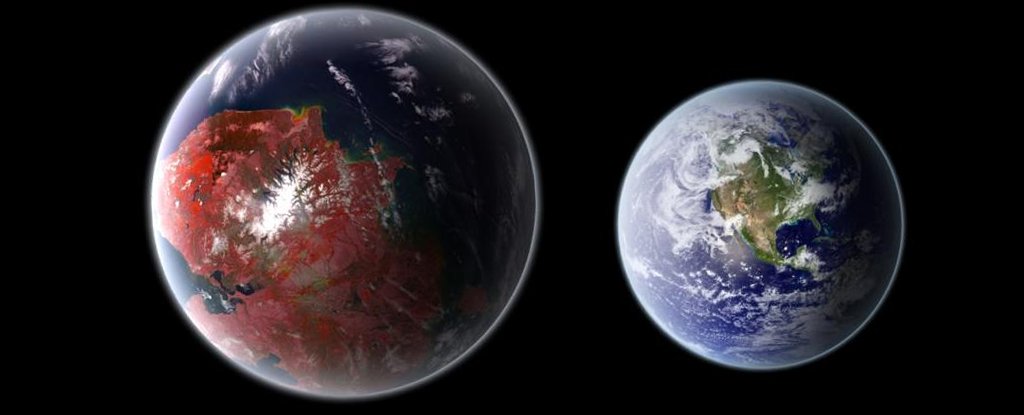Products You May Like
Life currently has a sample size of just one. Without an alien or two to expand the boundaries of biology, Earth’s evolutionary history sets the limits on whether we can expect other planets to spawn complex critters like, well, us.
Given many life forms owe a great debt to the oxygen in our atmosphere, it’s natural to look to other planets surrounded by a similar mix of gases in our search for aliens. But a new study suggests we’re going to need a lot of patience.
Researchers from the University of Naples Federico II and INAF Capodimonte Astronomical Observatory in Italy studied levels of light received by 10 potentially habitable exoplanets around different kinds of star, and failed to find a single match for Earth’s atmosphere.
Based on what we’ve observed of the thousands of planets found orbiting other stars, Earth is already a member of a relatively exclusive club. Once you’ve excluded numerous gas giants, roasted balls of rock, and frozen super-Earths, there aren’t many candidates that might have the kind of biochemistry we’re familiar with.
Still, if even a small fraction of billions of stars have a few large bodies circling close enough to allow liquid water to pool on their surfaces, we could be looking up at hundreds of millions of Gardens of Eden in our galaxy.
Growing even the simplest of gardens – at least by Earth’s standards – demands ample sunlight. Not just any kind of solar radiation will do, either. Rearranging carbon dioxide and water into glucose and those oh-so-handy oxygen molecules requires a quality of light energetic enough to generate reactions, without blasting apart proteins.
Given exoplanets in habitable zones generally receive plenty of sunlight, and the fact oxygenic photosynthesis arose so early in Earth’s history, it’d be fair to assume it to be quite a common process among the stars.
To test that assumption, the researchers took measures of light falling across different planetary surfaces and the spread of wavelengths making up the radiation, and calculated the level of ‘exergy’, or amount of work that could be squeezed out of the sunshine.
If only more of those stars were as nice as ours.
Most happen to be red dwarfs – temperamental suns capable of scouring their inner planets with furious winds that would quickly strip away their atmosphere.
Assuming there were planets capable of weathering such outbursts, the researchers found a red dwarf’s cooler temperatures would still be unlikely to provide an intensity of the right wavelengths to activate photosynthesis.
“Since red dwarfs are by far the most common type of star in our galaxy, this result indicates that Earth-like conditions on other planets may be much less common than we might hope,” says Covone.
Brighter stars would be better, churning out plenty of energy, but aren’t likely to live the billions of years required to pump out the oxygen complex life on Earth needed to get going.
In all, a star half as bright as our Sun could see photosynthesis get started, but would have a hard time generating a complex biosphere.
Among the planets used as case studies, precisely zero would be capable of fueling enough photosynthesis to tip an atmosphere flush with carbon dioxide into an Earth-like direction.
“This study puts strong constraints on the parameter space for complex life, so unfortunately it appears that the “sweet spot” for hosting a rich Earth-like biosphere is not so wide,” says Covone.
One planet we know of comes fairly close to that sweet spot.
Kepler-442b orbits an orange dwarf with roughly 60 percent the mass of the Sun’s, some 1,200 light years away. At around double the mass of Earth, and a rotation that allows it to shed heat, it’s looking like a potential paradise so far.
Most photosynthesizing reactions on Earth top out at wavelengths of around 700 nanometers. But if some kind of alien moss on Kepler-442b evolved a way to soak up slightly longer wavelengths, of around 800 nanometers, it would gain the benefits of 20 percent more photons.
As we expand our library of known worlds, it’s possible we’ll uncover better candidates for biospheres like ours.
Evolution continues to shock us on our own planet, so we can only imagine the diverse kinds of ecosystems possible out in the cosmos. Chemosynthetic ice moons might be in the majority, for all we know. Perhaps there are variations on photosynthesis we just can’t comprehend, given the limits of our experience on Earth.
Learning we’re unusual doesn’t mean we’re necessarily alone. But based on what we’re discovering, we can take a moment to appreciate our flavor of life is pretty special.
This study was published in Monthly Notices of the Royal Astronomical Society.
